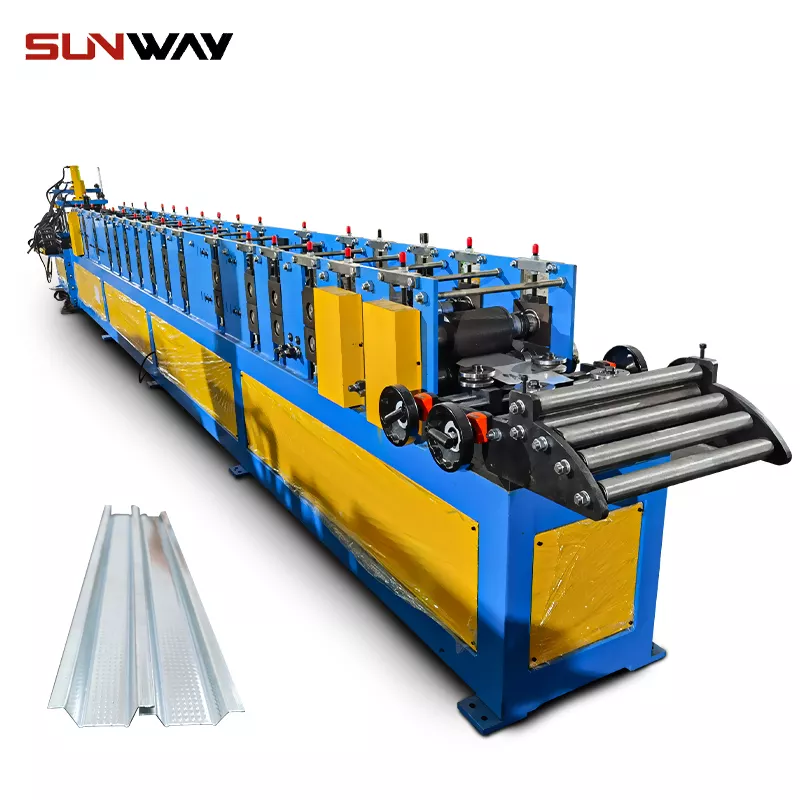
ए Profile Roll Forming Machine is a type of machine used in the manufacturing industry to produce metal profiles of various shapes and sizes. The machine works by passing a metal strip or coil through a series of rollers that gradually shape the metal into the desired profile.
The rollers are specially designed to bend the metal into a precise shape, with each roller set performing a specific bending operation. The process of rolling the metal is done gradually, with each successive set of rollers adding to the overall shape of the profile until it reaches the final desired shape.
-
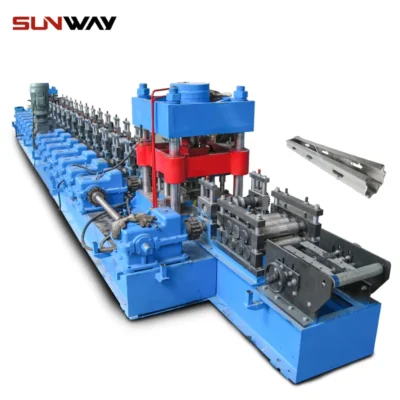 वाइनयार्ड पोस्ट रोल बनाने की मशीन
वाइनयार्ड पोस्ट रोल बनाने की मशीन -
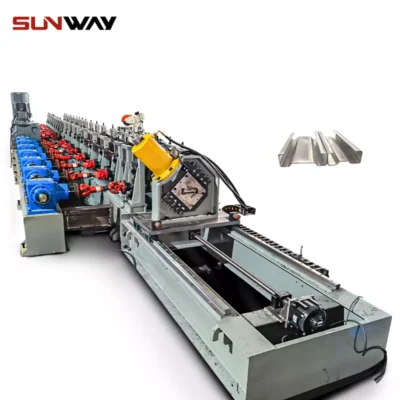 ऑटो आकार बदलने योग्य सिग्मा शहतीर रोल बनाने की मशीन
ऑटो आकार बदलने योग्य सिग्मा शहतीर रोल बनाने की मशीन -
 पीवी माउंटिंग ब्रैकेट सी शेप प्रोफाइल रोल बनाने की मशीन
पीवी माउंटिंग ब्रैकेट सी शेप प्रोफाइल रोल बनाने की मशीन -
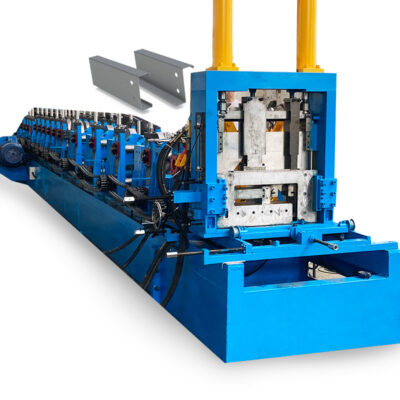 सीजेड शहतीर चैनल कोल्ड रोल बनाने की मशीन पूर्ण ऑटो जस्ती स्टील प्रोफाइल
सीजेड शहतीर चैनल कोल्ड रोल बनाने की मशीन पूर्ण ऑटो जस्ती स्टील प्रोफाइल -
 पीवी माउंटिंग ब्रैकेट रोल बनाने की मशीन (एचएटी / ओमेगा प्रोफाइल)
पीवी माउंटिंग ब्रैकेट रोल बनाने की मशीन (एचएटी / ओमेगा प्रोफाइल) -
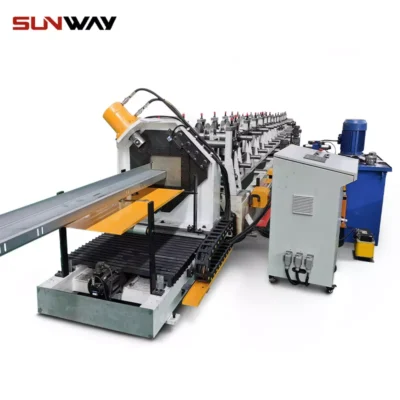 पीवी माउंटिंग ब्रैकेट जेड शेप प्रोफाइल रोल बनाने की मशीन
पीवी माउंटिंग ब्रैकेट जेड शेप प्रोफाइल रोल बनाने की मशीन
Profile Roll Forming Machine advantages
There are several advantages of using a Profile Roll Forming Machine in the manufacturing industry. Here are some of the key benefits:
- High level of accuracy: Profile Roll Forming Machines are capable of creating metal profiles with a high degree of accuracy and consistency. This means that the final product meets the required specifications and tolerances, resulting in fewer defects and a more efficient manufacturing process.
- Ability to create complex shapes: Profile Roll Forming Machines are highly versatile and can produce profiles of varying complexity. The machine can create complex shapes and designs that would be difficult or impossible to achieve using other manufacturing methods.
- Reduced labor costs: Using a Profile Roll Forming Machine can significantly reduce labor costs in the manufacturing process. The machine can perform multiple bending operations in one pass, which eliminates the need for multiple workers and reduces the time required to produce a profile.
- Increased production speed: Profile Roll Forming Machines are designed to produce profiles at a high rate of speed, which increases the overall production capacity of the manufacturing process. This results in faster turnaround times and increased output.
- Consistent quality: The consistent and repeatable nature of the profile roll forming process ensures that each profile produced is of the same quality as the previous one. This means that the final product meets the required standards and specifications, resulting in fewer defects and a more efficient manufacturing process.
- Reduced material waste: The roll forming process is a precise and controlled process that minimizes material waste. The machine can produce profiles with minimal scrap or material waste, which reduces the overall cost of production.
Profile Roll Forming Machine applications
Profile Roll Forming Machines are used in a wide range of industries and applications. Here are some of the common applications of Profile Roll Forming Machines:
- Construction industry: Profile Roll Forming Machines are widely used in the construction industry to produce metal profiles for roofing and cladding systems, structural members, and framing systems.
- Automotive industry: Profile Roll Forming Machines are used in the automotive industry to produce a variety of parts, including door frames, bumper reinforcements, and exhaust system components.
- Aerospace industry: Profile Roll Forming Machines are used in the aerospace industry to produce structural components for aircraft, such as fuselage frames and wing components.
- Electrical industry: Profile Roll Forming Machines are used in the electrical industry to produce metal profiles for electrical enclosures, cable trays, and conduit systems.
- Agricultural industry: Profile Roll Forming Machines are used in the agricultural industry to produce metal profiles for farming equipment, such as grain bins, silos, and fencing systems.
- Furniture industry: Profile Roll Forming Machines are used in the furniture industry to produce metal profiles for furniture frames, including chairs, tables, and shelves.
- Medical industry: Profile Roll Forming Machines are used in the medical industry to produce metal profiles for medical equipment and devices, including hospital beds and surgical instruments.
Overall, Profile Roll Forming Machines are used in a variety of industries and applications where precise and efficient production of metal profiles is required.
Types of profile roll forming machines
There are several types of Profile Roll Forming Machines used in the manufacturing industry. Here are some of the common types:
- Single-pass machines: Single-pass machines are the most basic type of Profile Roll Forming Machine. They are designed to create simple profiles in one pass through the machine.
- Multi-pass machines: Multi-pass machines are more complex than single-pass machines and are capable of producing more complex profiles in multiple passes through the machine. They are designed to bend the metal strip or coil through several sets of rollers to create the final profile.
- Flexible machines: Flexible machines are designed to produce a wide range of profiles with minimal tool changes. They can be quickly reconfigured to produce different profiles by adjusting the positions of the rollers or changing the tooling.
- Post-cut machines: Post-cut machines are used to produce metal profiles that require a specific length. They cut the profile to the desired length after it has been formed.
- Pre-cut machines: Pre-cut machines are used to produce metal profiles that require a specific length before forming. They cut the metal strip or coil to the desired length before it enters the machine.
- In-line machines: In-line machines are designed to be integrated into a continuous manufacturing process, with the metal strip or coil fed directly from the previous operation.
- Offline machines: Offline machines are standalone machines that can be used independently of the main manufacturing process. They are often used for prototyping or small-batch production.
Each type of Profile Roll Forming Machine has its own advantages and disadvantages, and the choice of machine depends on the specific needs of the manufacturing process.
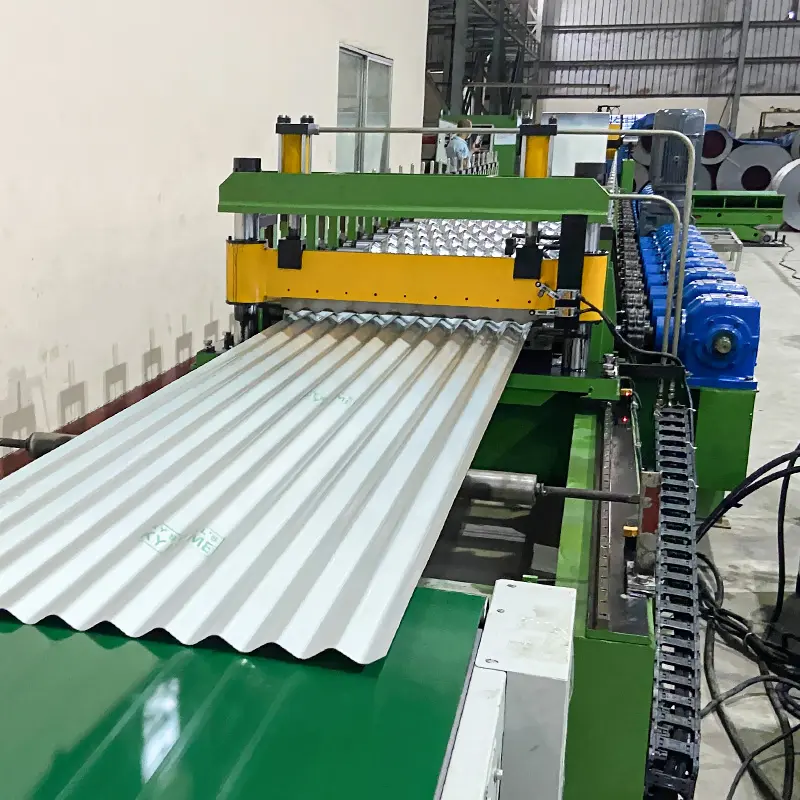
Factors to consider when buying a profile roll forming machine
When buying a Profile Roll Forming Machine, there are several factors to consider. Here are some of the key factors to keep in mind:
- Material size and thickness: The size and thickness of the metal strip or coil that will be used in the roll forming machine is an important consideration. The machine should be able to accommodate the size and thickness of the material needed for the desired profiles.
- Required output: The required output of the machine is another important consideration. The machine should be able to produce the required number of profiles in the desired time frame.
- Level of automation: The level of automation of the machine can vary greatly, from basic manual machines to fully automated systems. The choice of machine depends on the specific needs of the manufacturing process, including the required level of accuracy, repeatability, and efficiency.
- Profile complexity: The complexity of the profiles to be produced is an important consideration. More complex profiles may require a more advanced machine with greater capabilities.
- Tooling and changeover time: The tooling required to produce the desired profiles is another important consideration. The machine should be able to accommodate the required tooling, and the changeover time between different profiles should be as short as possible.
- Maintenance requirements: The maintenance requirements of the machine should also be considered, including the need for regular cleaning, lubrication, and replacement of worn parts.
- Manufacturer and supplier reputation: The reputation of the manufacturer and supplier should also be considered. It’s important to choose a reputable manufacturer and supplier with a track record of producing high-quality machines and providing reliable customer support.
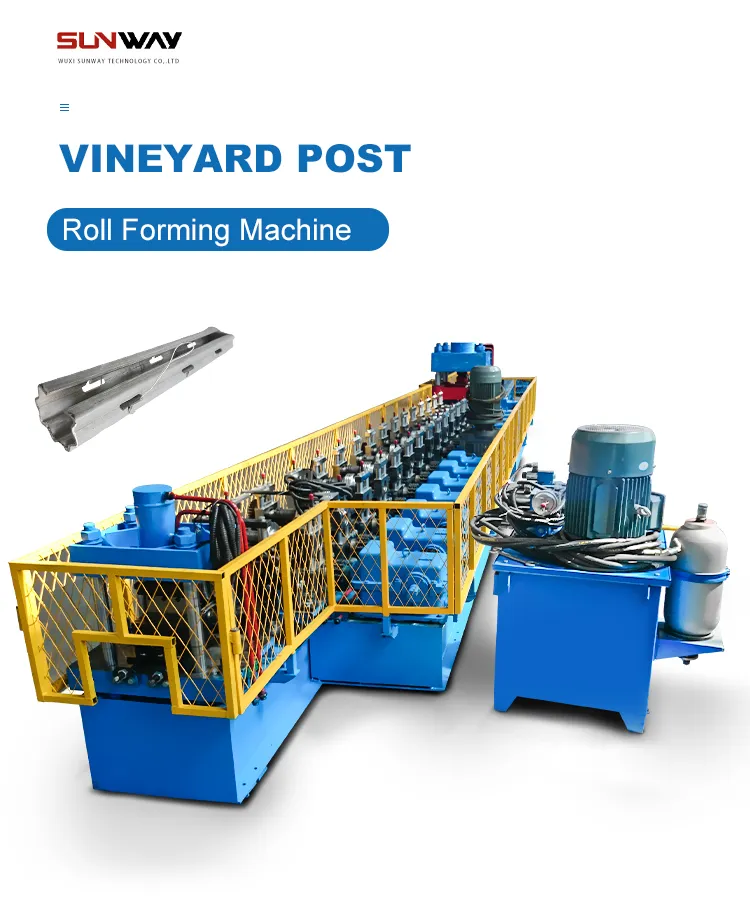
Key features of profile roll forming machines
Profile Roll Forming Machines have several key features that make them ideal for producing metal profiles in the manufacturing industry. Here are some of the important features of Profile Roll Forming Machines:
- Roller design: The rollers of a Profile Roll Forming Machine are specially designed to bend the metal strip or coil into the desired shape. The design of the rollers can vary depending on the complexity of the profile to be produced.
- Speed: The speed of a Profile Roll Forming Machine is an important consideration. The machine should be able to produce the required number of profiles in the desired time frame.
- Accuracy: The accuracy of the machine is critical to ensuring that each profile produced meets the required specifications and tolerances.
- Repeatability: The repeatability of the machine is important to ensure that each profile produced is consistent in quality and meets the required standards.
- Level of automation: The level of automation of the machine can vary greatly, from basic manual machines to fully automated systems. The choice of machine depends on the specific needs of the manufacturing process, including the required level of accuracy, repeatability, and efficiency.
- Flexibility: The flexibility of the machine is important to ensure that it can be adapted to produce different profiles as needed.
- Tooling: The tooling required to produce the desired profiles is an important consideration. The machine should be able to accommodate the required tooling, and the changeover time between different profiles should be as short as possible.
- Maintenance requirements: The maintenance requirements of the machine should also be considered, including the need for regular cleaning, lubrication, and replacement of worn parts.
Overall, Profile Roll Forming Machines are designed to be versatile, accurate, and efficient in producing metal profiles of varying complexity.
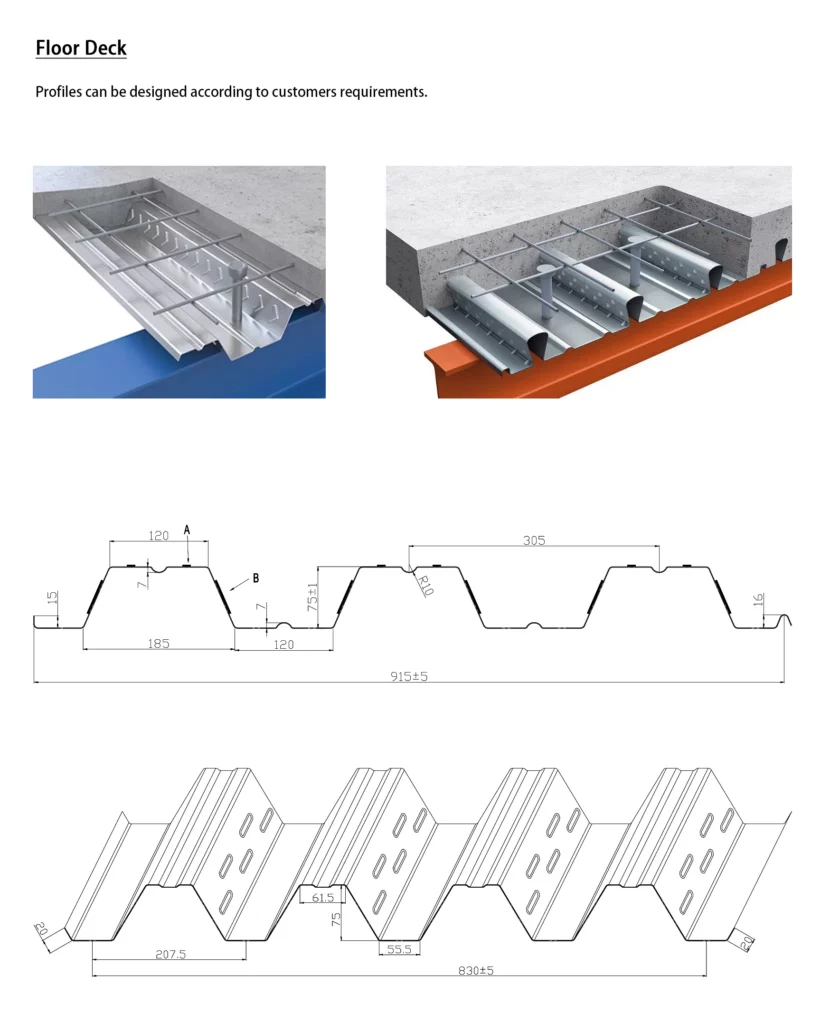
where to buy profile roll forming machines?
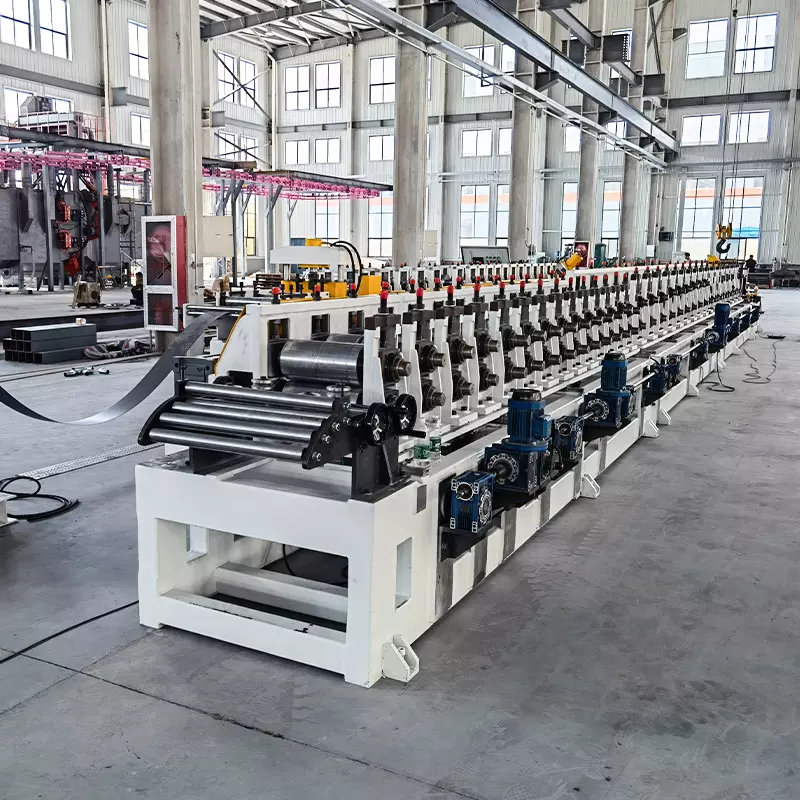
Profile Roll Forming Machines can be purchased from various manufacturers and suppliers around the world. Here are some places to consider when looking to buy a Profile Roll Forming Machine:
- Manufacturer websites: Many manufacturers of Profile Roll Forming Machines have their own websites where you can browse their products and place orders directly.
- Online marketplaces: Online marketplaces like Alibaba, Amazon, and eBay offer a wide selection of Profile Roll Forming Machines from various manufacturers and suppliers around the world.
- Trade shows: Attending trade shows related to the manufacturing industry is a great way to connect with manufacturers and suppliers of Profile Roll Forming Machines and see the machines in action.
- Referrals: Referrals from colleagues or other businesses in the industry can be a valuable source of information on where to buy Profile Roll Forming Machines.
- Local distributors: Some manufacturers of Profile Roll Forming Machines have local distributors or representatives who can provide information and assistance in purchasing the machine.
When considering where to buy a Profile Roll Forming Machine, it’s important to choose a reputable manufacturer or supplier with a track record of producing high-quality machines and providing reliable customer support. Additionally, it’s important to consider factors like shipping and installation, as well as the cost and availability of replacement parts and maintenance services.
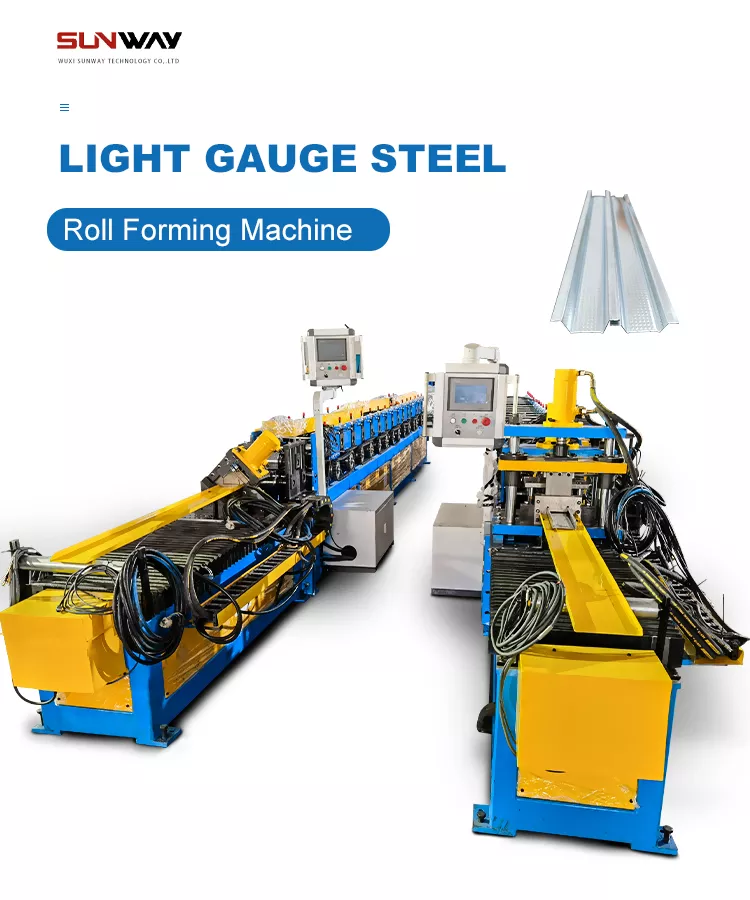
Chinese profile roll forming machine advantages
There are several advantages to purchasing a Chinese-made Profile Roll Forming Machine. Here are some of the key benefits:
- Cost-effective: Chinese-made Profile Roll Forming Machines are often more cost-effective than machines made in other countries. This is because labor and material costs in China are generally lower than in other parts of the world.
- Wide selection: Chinese manufacturers offer a wide selection of Profile Roll Forming Machines, from basic manual machines to fully automated systems. This means that there is a machine available to meet the specific needs of any manufacturing process.
- High-quality components: Many Chinese manufacturers use high-quality components in their machines, including motors, gears, and bearings. This ensures that the machines are durable and reliable.
- Customization: Chinese manufacturers often offer customization options for their machines, including the ability to adjust the size and shape of the machine to meet the specific needs of the manufacturing process.
- Large production capacity: Chinese manufacturers have large production capacity, which means they can produce a high volume of machines in a short period of time. This makes it easier to get the machine you need quickly.
- Efficient production process: Chinese manufacturers have streamlined their production processes, which means that they can produce machines quickly and efficiently without sacrificing quality.
Overall, purchasing a Chinese-made Profile Roll Forming Machine can be a cost-effective way to acquire a high-quality machine that is tailored to the specific needs of your manufacturing process.
Chinese profile roll forming machine price
The price of a Chinese-made Profile Roll Forming Machine can vary depending on several factors, including the machine’s specifications, level of automation, and customization requirements. Generally, Chinese-made machines tend to be more cost-effective than machines made in other countries due to lower labor and material costs.
Basic manual machines can start at around $3,000 USD, while fully automated systems with advanced features and customization options can cost several hundred thousand dollars. It’s important to keep in mind that the final price of the machine may also include additional costs, such as shipping, customs fees, and installation.
When considering the price of a Chinese-made Profile Roll Forming Machine, it’s important to compare prices and features from multiple manufacturers to ensure that you are getting a competitive price for the machine that meets your specific needs. Additionally, be sure to work with a reputable manufacturer with a track record of producing high-quality machines and providing reliable customer support.
How to import profile roll forming machine from china?
Importing a Profile Roll Forming Machine from China can be a complex process, but here are some general steps to follow:
- Find a reputable Chinese manufacturer: Start by researching and identifying reputable manufacturers of Profile Roll Forming Machines in China. You can find manufacturers through online directories, trade shows, or referrals from colleagues or other businesses in the industry.
- Request a quote: Contact the manufacturer and request a quote for the machine you are interested in purchasing. Be sure to provide as much detail as possible, including the specifications of the machine and any customization requirements.
- Negotiate the terms of the purchase: Once you have received a quote, negotiate the terms of the purchase with the manufacturer, including the price, delivery date, and payment terms.
- Arrange for shipping and customs clearance: You will need to arrange for shipping of the machine from China to your country and for customs clearance. This may involve working with a freight forwarder or customs broker.
- Arrange for installation and commissioning: Once the machine has arrived, you will need to arrange for installation and commissioning. This may involve hiring a local technician or working with the manufacturer to provide installation and commissioning services.
- Train operators: It’s important to train operators on how to use the machine properly to ensure that it operates safely and efficiently.
- Maintain the machine: Regular maintenance of the machine is important to ensure its continued performance and longevity. Be sure to follow the manufacturer’s recommended maintenance schedule and procedures.
Importing a Profile Roll Forming Machine from China can be a complex process, so it’s important to work with experienced professionals and to ensure that all legal and regulatory requirements are met.
जाँच करना
Frequently Asked Questions (FAQ)
1) Can one Profile Roll Forming Machine handle multiple profiles without full tooling swaps?
- Yes. 2025 auto size-change systems allow servo-adjustable stands and cassette tooling for families of profiles (e.g., C/U/Hat/Omega). Expect 5–20 minute changeovers if flower designs are compatible and coil specs are within the machine’s forming window.
2) What metals and coatings are best suited for high-volume profile roll forming?
- Galvanized and Galvalume steel (G250–G550), aluminum (3xxx/5xxx series), and stainless (304/316) are common. For corrosion resistance, use AZ150–AZ200, ZM/ZAM coatings, or PVDF paint systems. Hardened or nitrided rolls are recommended for stainless and high-strength substrates.
3) How do I improve cut-length accuracy on long parts?
- Use closed-loop encoder feedback on the flying shear, maintain constant strip tension, calibrate entry guides, and add laser length verification. Best-in-class accuracy is ±0.5–1.0 mm per 6 m on modern lines.
4) What affects profile straightness (twist, bow, camber) and how to correct it?
- Causes include unbalanced pass progression, incorrect roll gaps, and non-uniform material. Remedies: re-validate flower design, balance forming loads, adjust entry/exit straighteners, and stabilize coil payoff with dancer/brake control.
5) What utilities and floor space should I plan for a mid-size profile roll forming machine?
- Typical: 380–480 V 3-phase, 20–80 kVA connected load, 6–8 bar compressed air, hydraulic unit (if punching/notching). Line length 15–30 m plus 3–5 m service space; heavier lines may exceed 40 m with stacking/packaging.
2025 Industry Trends for Profile Roll Forming Machines
- Auto-adjust and digital twins: Recipe-driven servo stands and virtual commissioning cut changeovers and commissioning scrap.
- Inline quality and traceability: Vision systems check hole positions, flange angles, and surface defects; data tied to coil pedigree in MES/ERP.
- Forming high-strength/lightweight materials: Growing use of G550, AHSS, and Al-Mg alloys drives adoption of higher torque drives and hardened tooling.
- Energy efficiency as KPI: Regenerative VFDs, smart idle, and compressed-air optimization reduce kWh/ton by double digits.
- Safety by design: Increased adoption of ISO 13849 PLd/SIL2 safety controls and EN ISO 14120 guarding for CE markets.
- Modular punching/notching: Servo punching modules relocate inline, enabling quick reconfiguration for SKUs without full die swaps.
2025 Benchmarks and Adoption Metrics
| Metric | 2023 Typical | 2025 Best-in-Class | 2025 Common Range | Notes/Sources |
|---|---|---|---|---|
| Size-change (same family) | 25–45 min | 6–12 min | 10–25 min | SME; OEM demos |
| Line speed (forming) | 20–45 m/min | 60–90 m/min | 35–70 m/min | Vendor catalogs |
| Cut-length accuracy (6 m) | ±2–4 mm | ±0.5–1.0 mm | ±1–2 mm | Encoder + laser verify |
| Startup scrap (%) | 3–5% | 1–2% | 1.5–3% | Inline vision/laser |
| Energy intensity (kWh/ton) | 150–210 | 110–150 | 120–180 | DOE AMO guidance |
| HSLA/G550 usage (%) | ~25% | ~45% | 30–45% | Market analyses |
| Traceability adoption (%) | ~30% | ~70% | 45–65% | MES/ERP integration |
Selected references:
- U.S. DOE Advanced Manufacturing Office: https://www.energy.gov/amo
- Society of Manufacturing Engineers (SME): https://www.sme.org
- ISO Standards (ISO 12100, ISO 13849, EN ISO 14120): https://www.iso.org
- ASTM/EN materials and coatings: https://www.astm.org
Latest Research Cases
Case Study 1: Auto Size-Change Retrofit for Multi-Profile Production (2025)
Background: A fabrication plant producing C/U channels and Omega PV brackets struggled with 40-minute changeovers and 4% startup scrap on a 2015 line.
Solution: Added servo-positioned stands, cassette tooling for shared flower designs, inline vision for flange angle and hole offset, and MES connectivity for coil-to-part genealogy.
Results: Average changeover reduced to 11 minutes; startup scrap cut to 1.8%; OEE improved from 62% to 77%; first-pass yield up 5.4%.
Case Study 2: Energy Optimization on High-Strength Steel Line (2024)
Background: Manufacturer forming G450–G550 profiles faced rising energy bills and inconsistent cut-length during summer heat.
Solution: Implemented regenerative VFDs, smart idle logic, compressed-air leak audit, and recalibrated flying shear with thermal compensation; upgraded to nitrided rolls.
Results: Energy intensity down 17% kWh/ton; cut-length variance improved by 0.9 mm over 6 m; defect rate on G550 reduced 43%; ROI in 14 months.
Sources: DOE AMO energy case guidance; SME technical briefs; aggregated OEM field notes
Expert Opinions
- Dr. Anna K. Kowalski, Director, Roll Forming Research Institute, University of Kassel
Viewpoint: “For high-strength substrates, servo-controlled pass gaps paired with inline bow sensing deliver the best stability gains per euro spent.”
Source: https://www.uni-kassel.de - Michael Klipfel, Product Manager, The Bradbury Group
Viewpoint: “By 2025, buyers expect recipe-based size changes under 15 minutes and full digital traceability across every profile roll forming machine.”
Source: https://bradburygroup.com - Dr. Markus Heine, CTO, Data M Sheet Metal Solutions (COPRA RF)
Viewpoint: “Digital twins and simulated flower designs reduce commissioning time and ensure robust forming windows for mixed-material portfolios.”
Source: https://www.data-m.de
Practical Tools/Resources
- Roll design and simulation: COPRA RF — https://www.data-m.de
- Inline metrology and vision: Keyence — https://www.keyence.com
- Energy efficiency playbooks: DOE AMO — https://www.energy.gov/amo
- Safety standards and guidance: ISO 12100, ISO 13849, EN ISO 14120 — https://www.iso.org
- Manufacturing execution/traceability: Siemens Opcenter — https://www.siemens.com
- Professional training and SME resources: https://www.sme.org
- CMMS for preventive maintenance: UpKeep — https://www.onupkeep.com
Last updated: 2025-10-27
Changelog: Added 5 new FAQs; included 2025 trend section with benchmark table; created two recent case studies; provided expert viewpoints; curated practical tools/resources with authoritative links
Next review date & triggers: 2026-04-30 or earlier if OEMs release sub-10-minute multi-profile changeovers at ≥70 m/min, new ISO/ASTM materials or safety standards update, or DOE publishes revised energy intensity benchmarks for roll forming
